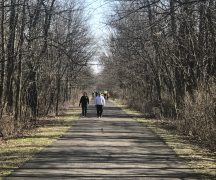The coronavirus pandemic has been grinding on for so many months that it’s easy to become numb to its staggering cost. But now, as the United States is crossing the grim milestone of 500,000 dead from the disease, it seems as if February 2020 marked the end of a different, easier era.
In Ohio, where nearly 17,000 have died, nearly 900,000 have fallen ill, many with lingering symptoms and medical bills. Hundreds of thousands more are out of work and on the verge of hunger and homelessness.

a statewide address.
Photo courtesy Ohio Channel.
On Monday, as Gov. Mike DeWine described a personal coronavirus routine that starts with 6:30 a.m. calls to Ohio hospitals, he said there was no way last February to know what profound, persistent changes were around the bend.
“Certainly I did not have any idea of the magnitude of what we were headed into,” he said. “I don’t think anybody really understood — maybe somebody did — but no, I did not know that. I had no idea that, nationwide, we’d be crossing this figure of a half a million people dead.”
As with many — especially those of a certain age — the losses have been personal for the 74-year-old governor.
“I was thinking this morning, just the number of people I know who are friends who are now gone,” he said. “I mean, good friends who are now gone from covid. From the beginning of this, I had no idea what we would be going through for this year.”
As a Republican governor who tried to take a science-first approach to the covid fight, DeWine spent most of the last year stuck between a rock and a hard place.
Cases stayed low during sweeping shutdowns of bars, restaurants and other businesses. But in May, under intense pressure from constituents and from a Republican president who was tweeting at other governors to end lockdowns, DeWine ended many of the restrictions.
It’s unclear if it was related to eased restrictions, but cases and deaths from covid began spiking in the fall. DeWine faced relentless criticism from both sides — some telling him to reimpose restrictions and others calling him a tyrant over the few that remained.
DeWine was asked Monday what he’d do differently with the benefit of hindsight.
“If there’s one thing we know today that we did not know (at the beginning of the pandemic), it’s how powerful the masks are,” he said. “I don’t know if anybody understood that. But today we’ve got scientific testing. We’ve done research ourselves. We know how powerful these masks are; we know what they do.”
DeWine said the return of Ohio kids to school last fall confirmed his belief in their effectiveness.
“I know there are a lot of people watching right now who thought I had lost my mind,” he said. “What I heard was, ‘Little kids won’t wear masks. They won’t be compliant. This is a horrible thing.’ But we did it and what we found is that kids will wear masks. Adults will wear masks. And that stops the spread. That’s the one thing that I wish I knew at the beginning of this.”
Before that, however, the governor was more inconsistent on the subject of masks.
On April 27, he issued an order requiring retail workers and customers to wear masks. He reversed the part requiring customers to mask up a day later.
That was at a time when then-President Donald Trump was refusing to wear a mask in public and mocking others for doing so. DeWine didn’t reimpose the mask order until July 22. Even though Trump made many statements about the pandemic that were at odds with DeWine’s science-based approach, the governor steadfastly declined to contradict a president who would become seriously ill with a disease he refused to take seriously.
DeWine on Monday said that at some point, he and his team will look back at their coronavirus response and try to learn from it. But he said that with large numbers of Ohioans still getting sick and dying from the disease, there’s no time for that now.
“I look to the future, frankly,” the governor said. “I don’t have the luxury of spending much time going back and second-guessing myself or somebody else and thinking what we should have done. I’m sure there will be a time and a place for that, but we’re still in the middle of this storm and we’re still losing people, as you can see from the numbers.”
***
Also from Ohio Capital Journal:
CDC: Serious reactions to first 14 million COVID-19 vaccines extremely rare
Of the first nearly 14 million COVID-19 vaccine doses administered, serious adverse reactions were extraordinarily rare, according to CDC research published Friday.
The findings, reported in the agency’s Morbidity and Mortality Weekly Report, illustrate that the vaccine is a safe preventative for the overwhelming majority of its recipients.
“The postauthorization safety profiles for both vaccines are reassuring,” researchers wrote.
The researchers identified 62 cases of anaphylaxis, a potentially life-threatening allergic reaction, between Dec. 14 and Jan. 13.
This equates to 4.5 cases per million doses administered, the report states, an occurrence rate on par with other vaccines like the flu shot (1.4 per million), the pneumococcal polysaccharide vaccine (2.5 per million) and the shingles vaccine (9.6 per million). READ MORE
Ohio National Guard security detail after Jan. 6 cost state $1 million
It cost the state of Ohio more than $1 million to send hundreds of troops to the Ohio Statehouse last month to protect against acts of political violence.
All told, taxpayers spent millions of dollars to pay for enhanced security in Columbus and Washington, D.C. following the Jan. 6 events at the U.S. Capitol.
After the deadly insurrection at the nation’s capital, DeWine mobilized around 1,000 troops to D.C. to help with security for President Joe Biden’s inauguration. DeWine also authorized 480 troops to be stationed at the Ohio Statehouse during planned protests on inauguration week. READ MORE





